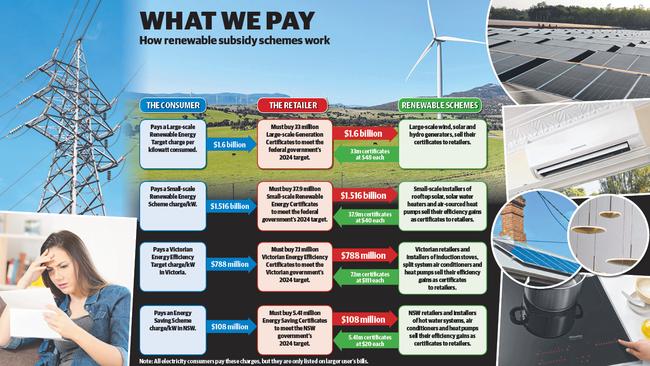Hidden cost: Renewables adding more than $3 billion to 2024 power bills
Most Australians don’t get to see the hefty federal and state charges they pay to subsidise solar farms, wind farms or energy efficiency schemes.

Australians will pay $3.1 billion in federal government renewable energy charges on their electricity bills this year – plus another $788m if they live in Victoria and $108m in NSW.
The charges, which make up about 16 to 17 per cent of every household and business electricity bill, are kept hidden on most accounts.
But the cost is itemised on large customers’ electricity bills, with Cobram Estate Olives paying $40,884 in renewable charges on its April bill of $261,732, and almost twice that amount to run its irrigation pumps during the summer months.
Cobram Estate Olives chair Robert McGavin said most Australians had no idea they were paying these charges.
“Every business is trying to have a go, but the government keeps loading them up with more lead in the saddle,” Mr McGavin said.

Carrot and vegetable grower Angelo Lamattina said the whole renewable charges scheme was a rort, which went against his business maxim that “if it doesn’t pay for itself, it’s wrong”.
Victoria’s 37 wind farms, operating at a capacity factor of a third over 24hrs for 365 days, are due to receive about $620m a year in taxpayer subsidies in 2024 – plus about twice that amount again from the sale of the electricity they generate.
The last set of financials published by Victoria’s smallest two-turbine wind farm, Hepburn Energy, shows it received $472,140 in taxpayer renewable energy subsidies in 2021-22, plus $701,326 from electricity sales.
The subsidies operate under federal and state government schemes that force electricity retailers to collect enough money from their customers to buy a target number of renewable energy certificates each year.
Retailers must then buy the certificates off large-scale wind and solar farms, or energy brokers and companies that collect small-scale certificates generated by households installing rooftop solar, LED lighting, induction stoves, split-system air conditioners or heat pumps.
For 2024 the federal government has set a large-scale renewable energy target of 33 million certificates, called LGCs, which retailers then have to buy off wind and solar farm owners for about $48 each – at a total cost to their electricity customers of almost $1.6 billion.
The Albanese Government has also set a small-scale renewable energy scheme target for 2024 of 37.9m certificates, called STCs, which retailers will have to buy for $40 each off companies offering rebates to households and businesses installing rooftop solar panels, heat pumps and even small wind turbines – at a total cost to electricity customers of more than $1.5 billion.
On top of that, Victoria and NSW governments have their own schemes.
In Victoria, retailers are on track to collect at least $788 million in Victorian energy efficiency target charges to meet the Allan Government’s mandated 2024 goal of buying 7.1 million certificates, called VEECs, off companies that collect them from households and businesses installing induction stoves, split-system air conditioners and heat pumps.
But energy brokers say the Victorian Government has strangled the supply of VEECs flowing onto the market, which has forced up the spot market price from S70/VEEC in May last year to $111/VEEC as of this week.
An Energy broker, who trades in VEECs, said the Victorian Government had decided it was too easy to create the certificates – which each represent a cut in greenhouse gas emissions of one tonne – first banning door-to-door sale of energy efficiency devices (mainly lighting) and more recently telemarketing.
“We need 150,000 (certificates) a week to come onto the market – for the remainder of the year – to meet the target,” the broker said. “But we’re only getting 80,000 a week.”
He said retailers who failed to meet their certificate target, based on the proportion of electricity they sold as a proportion of total consumption, would have to pay a shortfall penalty plus tax that brought the cost to $128 per certificate.
In contrast to Victoria, the NSW Energy Savings Scheme is awash with certificates, which each represent one megawatt-hour of energy saved from installing more efficient lighting, hot-water and air-conditioning systems.
The NSW Government set a target of 5.41 million energy savings certificates (STCs) for 2024, which are currently trading at $20 each, which will cost the state’s electricity customers about $108m this year.
The Clean Energy Council has previously stated “energy from wind or solar is the lowest cost form of new generation, and these costs continue to decrease year-on-year”.
The CEC also argues that renewable energy projects in Victoria and NSW contribute more than $4 million annually towards community benefit schemes, “including improvements to local infrastructure, support for fire services, local charities and Landcare groups and providing university scholarships”.



